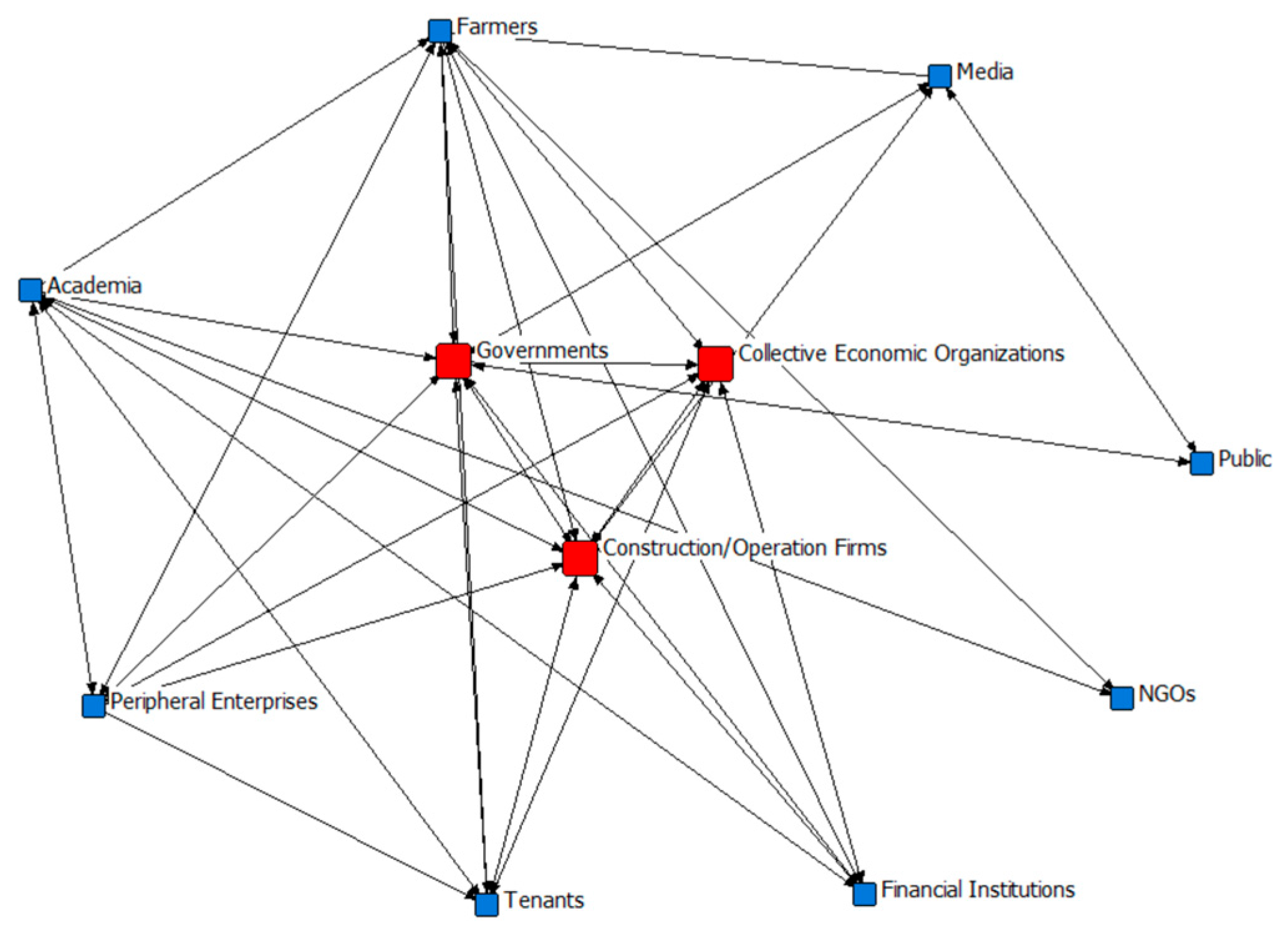3.1.4. Asymptotic Stability Analysis Under a Mixed Strategy
According to evolutionary game theory, each of the three participants will choose a corresponding strategy based on various factors, gradually tending toward a stable state. By conducting local stability analysis of the system’s Jacobian matrix, the evolutionarily stable strategy (ESS) of the system was obtained. Based on the replication dynamics equation of the system, the Jacobian matrix (J) of the system can be derived as follows:
Let
, and we obtain a total of 8 local equilibrium points. By substituting each equilibrium point into the matrix, the corresponding Jacobian matrix for each equilibrium point was obtained, along with the eigenvalues for each matrix, as shown in
Table 6.
According to Lyapunov’s first method, if an equilibrium point is an evolutionarily stable strategy (ESS), the corresponding eigenvalues of the Jacobian matrix should all be negative. In the above case, points A(0, 0, 1), D(1, 0, 0), and E(1, 0, 1) clearly do not satisfy the stability condition. The remaining stable points and equilibrium conditions are shown in
Table 7.
Scenario 1: When the local government chooses the “passive implementation” strategy, the collective economic organization chooses to “disagree” with the use of collective construction land for building rental houses, and the enterprise chooses “non-participation” in investing in and constructing rental houses, O(0, 0, 0) is the equilibrium point. The strategies of all three parties are stable and must satisfy the condition At this point, the payoff obtained by the collective economic organization is less than the sum of the development and operational costs, market risks, policy risks, and avoidable losses borne by the collective economic organization if it participates while the other two parties do not. As a result, the BRHCOCL pilot policy will be in a state of stagnation.
Scenario 2: When the local government chooses the “passive implementation” strategy, the enterprise chooses the “non-participation” strategy, and the collective economic organization adopts the “agreement” strategy and is willing to bear the development and construction costs, B(0, 1, 0) becomes the equilibrium point. The strategies of all three parties are stable and must satisfy the following conditions: , and
This means that the local government’s payoff must be greater than the losses it can avoid, as well as the communication and coordination costs with the enterprise when the enterprise chooses the “non-participation” strategy, while the collective economic organization’s payoff must be greater than the sum of the development and operational costs, market risks, policy risks, and avoidable losses borne by the collective economic organization when the other two parties do not participate.
The financial subsidy received by the collective economic organization, the payoff received by the enterprise, and the market risks faced by the collective economic organization when the enterprise chooses the “participation” strategy, along with the legal risks faced by the enterprise in the “participation” strategy, must be less than the sum of the market risks, policy risks, and the development and operational costs borne by the collective economic organization when the other two parties do not participate. In such a case, the collective economic organization must independently bear the development and construction costs, as well as various risks, making policy implementation very difficult.
Scenario 3: When the local government chooses the “passive implementation” strategy, the collective economic organization adopts the “agree” strategy, and the enterprise chooses the “participation” strategy, C(0, 1, 1) is the equilibrium point. The strategies of all three parties are stable and must simultaneously satisfy the following conditions: , and .
This implies that the payoff for local government when it adopts the “active implementation” strategy must be less than the losses it can avoid by choosing the “passive implementation” strategy.
The payoff for the collective economic organization when it adopts the “agree” strategy must be greater than the bargaining costs with the enterprise and the losses it can avoid by choosing the “disagree” strategy, considering the market risks faced by the collective economic organization when the enterprise adopts a “participation” strategy, and the legal risks faced by the local government when it adopts the “passive implementation” strategy.
When the collective economic organization adopts the “agree” strategy and the enterprise adopts the “participation” strategy, the developmental and operational costs met by the enterprise, the cost of bargaining between the two, the losses the enterprise can avoid by choosing the “non-participation” strategy, and the market and policy risks faced by the collective economic organization when the enterprise chooses the “non-participation” strategy must be less than the benefits the enterprise gains, with regard to the financial subsidies as well as the market and policy risks the collective economic organization faces when the enterprise adopts the “participation” strategy.
At this point, the collective economic organization and the enterprise cooperate to develop and construct rental houses, with the enterprise bearing the costs of development and construction. There are no financial subsidies, and the enterprise focuses on the ration of risk shared with the collective economic organization. In the context of underdeveloped rules and procedures for transactions involving collective land, when the local government chooses the “passive implementation” strategy, the collective economic organization lacks the capacity and strength to bear risks. With low returns from the BRHCOCL project, it is difficult for enterprises and collective economic organizations to reach cooperative agreement. However, when the government’s transaction rules are relatively sound, the transaction platform is transparent, the approval process is efficient, the rural collective land market is well developed, the collective economic organization has the negotiating power to engage with the enterprise without government intervention, and rental house building is profitable, the collective economic organization and the enterprise can cooperate with minimal government intervention.
Scenario 4: When the local government chooses the “active implementation” strategy, the collective economic organization adopts the “agree” strategy, but the enterprise chooses the “non-participation” strategy, F(1, 1, 0) becomes the equilibrium point. The strategies of all three parties are stable and must simultaneously satisfy the following conditions: , and .This means that the payoff for local government when it adopts the “active implementation” strategy must be greater than the communication and coordination costs incurred by the enterprise when it chooses the “non-participation” strategy in addition to losses the local government can avoid by adopting the “passive implementation” strategy.
The development and operational costs borne by the collective economic organization when the enterprise chooses the “non-participation” strategy, the losses the collective organization can avoid by adopting the “disagree” strategy, and the market risks the collective organization bears when it chooses the “agree” strategy and the enterprise chooses the “non-participation” strategy must be less than the payoff the collective economic organization receives when it chooses the “agree” strategy combined with the financial subsidies it receives when the enterprise chooses the “non-participation” strategy.
The payoff the enterprise receives, the financial subsidies, and the market risks the collective economic organization bears when the enterprise chooses the “participation” strategy must be less than the development and operational costs, bargaining costs, market risks, and avoidable losses when the enterprise chooses the “non-participation” strategy.
Under these circumstances, the enterprise chooses “non-participation” in the BRHCOCL project due to reasons such as insufficient funds and excessive risks. Although the collective economic organization agrees to the project and has some level of financial strength, it is unable to complete the project on its own. Government financial subsidies and policy guarantees are necessary for the project to move forward. Once completed, the building will be leased to the government for unified management, and it will be incorporated into the local public rental housing system.
Scenario 5: When the local government chooses the “active implementation” strategy, the collective economic organization adopts the “agree” strategy, and the enterprise chooses the “participation” strategy, G(1, 1, 1) becomes the equilibrium point. The strategies of all three parties are stable and must simultaneously satisfy the following conditions: , and .This means that the payoff for local government when it adopts the “active implementation” strategy must be greater than the losses it can avoid by adopting the “passive implementation” strategy, while the bargaining costs between the collective economic organization and the enterprise, the market risks borne by the collective economic organization, and the losses it can avoid by adopting the “disagree” strategy must be less than the benefits the collective economic organization receives when it adopts the “agree” strategy and the enterprise adopts the “participation” strategy.
The development and operational costs, bargaining costs, and the market risks faced by the collective economic organization when the enterprise chooses the “participation” strategy must be less than the benefits and financial subsidies the enterprise receives when it chooses the “participation” strategy, along with the market risks the collective economic organization bears.
In this situation, the government acts as a bridge between the collective economic organization and the enterprise, promoting the implementation of BRHCOCL policy. The government actively completes pilot tasks, communicates and coordinates with the collective economic organization to reduce bargaining costs, helps the collective economic organization obtain land revenue, and allows the enterprise to bear development and construction costs along with some market risks. The government provides financial support to the enterprise and helps mitigate policy risks, ensuring the smooth progress of the BRHCOCL project.
The above analysis indicates that only when two of the three parties—local government, enterprises, and collective economic organizations—cooperate, or when all three parties collaborate, is it likely that the BRHCOCL pilot policy will be successfully implemented. The actions of one party influence the behavioral choices of the other two parties. Key factors that influence the decisions of the three stakeholders include local government attitude toward the pilot policy, the cost of communication and coordination between the three parties, the collective economic organization’s cognitive capacity and ability to engage in the market economy, as well as the benefits that the collective economic organization and enterprises gain from participating in the BRHCOCL project. These factors are not only central to the interests of stakeholders but are also key elements that can trigger conflicts among core stakeholders. When one or two of the three parties is unwilling to participate in the BRHCOCL projects, it indicates an irreconcilable conflict among the core stakeholders, manifesting as high communication and coordination costs, insufficient capability, and difficulties in sharing risks.















